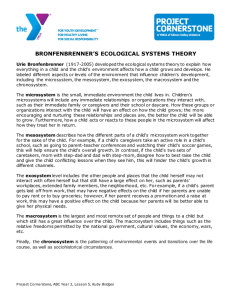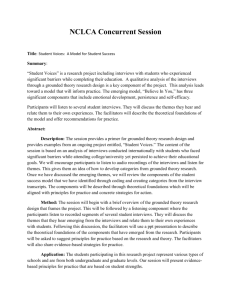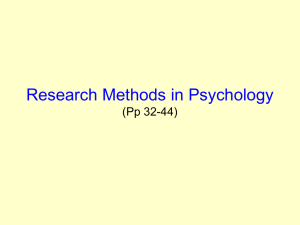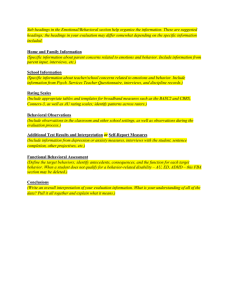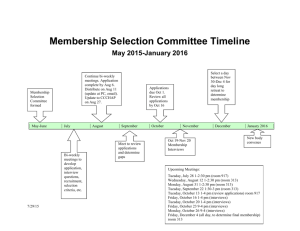IARSLCE--2012--VERY FINAL PESM SYMPOSIUM SLIDES
advertisement
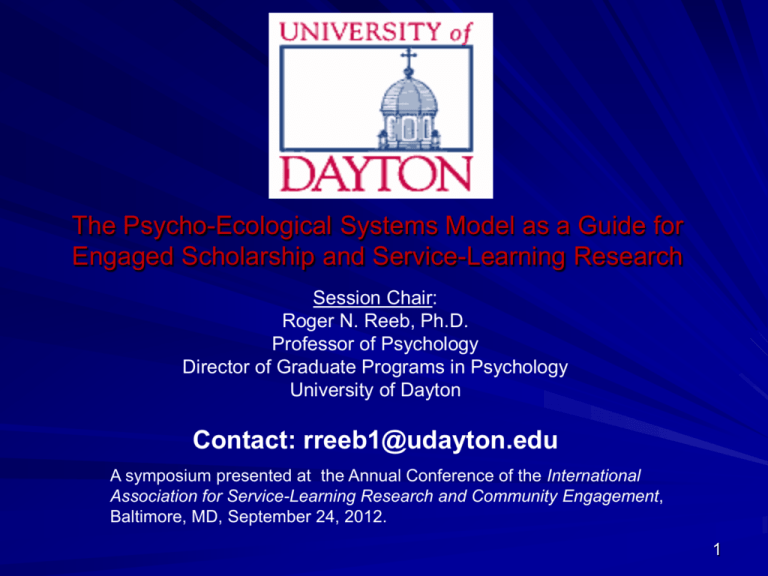
The Psycho-Ecological Systems Model as a Guide for Engaged Scholarship and Service-Learning Research Session Chair: Roger N. Reeb, Ph.D. Professor of Psychology Director of Graduate Programs in Psychology University of Dayton Contact: rreeb1@udayton.edu A symposium presented at the Annual Conference of the International Association for Service-Learning Research and Community Engagement, Baltimore, MD, September 24, 2012. 1 Psycho-Ecological Systems Model of Engaged Scholarship and Service-Learning Research: Multidisciplinary Applications Session Chair: – Roger N. Reeb, Ph.D., University of Dayton Presenters: – Theo Majka, Ph.D. and Linda Majka, Ph.D. , University of Dayton – Katherine Coder, Ph.D., University of Miami – Shawn Cassiman, Ph.D., University of Dayton – Laura Stayton, Annie Steel, Nyssa Snow, Sara Mason, Sarah Bidwell, Kirsten Kasper, Alisa Bartel, Haylee DeLuca, Adrienne Anderson, Graduate Students at University of Dayton Discussant: – Robert G. Bringle, Ph.D., Professor of Psychology, Appalachian State University; Senior Scholar, Center for Service and Learning, IUPUI 2 Purpose of Presentation 3 Purpose of Presentation To describe a new conceptual model to assist in guiding engaged scholarship and service-learning 4 Purpose of Presentation To describe a new conceptual model to assist in guiding engaged scholarship and service-learning To review a number of projects within the context of the model 5 Purpose of Presentation To describe a new conceptual model to assist in guiding engaged scholarship and service-learning To review a number of projects within the context of the model To generate ideas for future development of the model 6 Background Publication: – Reeb, R. N., & Folger, S. F. (2013). Community outcomes in service learning: Research and practice from a systems theory perspective. In P. H. Clayton, R. G. Bringle, & J.A. Hatcher (Eds.). Research on Service Learning: Conceptual Frameworks and Assessment (pp. 389-418). Sterling, VA: Stylus Publishing. Local Presentation: – Stander Symposium, University of Dayton, 2011 Regional Presentation: – Southwestern Ohio Council for Higher Education, 2011 National Presentation: – American Psychological Association, 2011 International Presentations: – IARSLCE, 2010, 2011 – International Symposium on Service-Learning, Ningbo, Zhejiang, China, 2011 7 Psycho-Ecological Systems Model of Community Action Research (PESM) PESM integrates three theoretical developments: – Principle of Reciprocal Determinism Bandura, A. (1978). The self system in reciprocal determinism. American Psychologist, 33, 344-358. – Biopsychosocial Model Kiesler, D. J. (2000). Beyond the disease model of mental disorders. Westport, CT: Praeger Publishers. – Ecological Systems Model Bronfenbrenner, U. (1996). The ecology of human development: Experiments by nature and design. Cambridge, MA: Harvard University Press. 8 Psycho-Ecological Systems Model of Community Action Research (PESM) Purpose of PESM – PESM was developed to inform and guide community interventions, including those associated with engaged scholarship and service-learning. 9 Psycho-Ecological Systems Model for Community Action Research 10 Principle of Reciprocal Determinism P B P = Person Factors E E = Environmental Factors B = Behavior 11 Biopsychosocial Model Internal Factors – Vulnerability Factors – Resiliency Factors – Developmental Factors External Factors – Risk Factors – Protective Factors 12 Psycho-Ecological Systems Model for Community Action Research 13 Psycho-Ecological Systems Model for Community Action Research Microsystem: “a pattern of activities, roles, and interpersonal relations experienced by the developing person in a given setting…” 14 Psycho-Ecological Systems Model for Community Action Research Mesosystem: “…a system of microsystems…” “it comprises the interrelationships among two or more settings in which the developing person actively participates…” 15 Psycho-Ecological Systems Model for Community Action Research Exosystem: “one or more settings that do not involve the developing person as an active participant, but in which events occur that affect, or are affected by, what happens in the setting containing the developing person” 16 Psycho-Ecological Systems Model for Community Action Research Macrosystem: “…overarching practices, beliefs, changes, and movements at broader levels (community, society, culture, government) that function as blueprints for action…” 17 Psycho-Ecological Systems Model for Community Action Research SupraMacrosystem: “…international or global influences, such as internationally-endorsed values (e.g., Millennium Development Goals)…” 18 Major Implications of PESM Participatory approach Multidisciplinary projects Multidimensional assessment of community outcomes Projects that enhance resiliency and resources in the community Projects that reduce vulnerability and risk factors in the community “Psychopolitical Validity” (Prilleltensky, 2008): – Enhance agency in community members and groups – Beyond ameliorative efforts, perhaps contributing to structural change Prilleltensky, I. (2008). The role of power in wellness, oppression, and liberation: The promise of psychopolitical validity. Journal of Community Psychology, 36, 116-136. 19 A Multidisciplinary Service-Learning Project for Homelessness UNIVERSITY OF DAYTON Graduate Student Presenters: – Laura Stayton, Annie Steel, Nyssa Snow, Sara Mason, Sarah Bidwell, Kirsten Kasper, Alisa Bartel, Haylee DeLuca, Adrienne Anderson, University of Dayton Faculty Advisor: – Roger N. Reeb, Ph.D. Faculty Consultant: – Shawn Cassiman, Ph.D. 20 Homelessness as a Major Social Problem It is important to look at the problem of homelessness at the national, state and local levels: – U.S.: approximately 3.5 million people per year (National Coalition for the Homeless, 2009) – Ohio: more than 12,000 people per night (Homeless Solutions, 2008) – Dayton: more than 950 people per night (Homeless Solutions, 2008) 10-Year Plan in Montgomery County: – Developed in 2004 21 Assessment of Resources/Assets and Needs This is a qualitative study utilizing interviews guided by PESM Purpose of Study: – Conduct an assessment of existing community resources/assets and needs related to homelessness – Conduct an assessment of relevant service-learning resources at the University of Dayton Long-Term Goal: – Multidisciplinary Service-Learning Project 22 Community Assessment Purpose of Interviews − Assessment of community resources/assets and needs related to homelessness at different PESM systems − What kind of projects would be helpful? Who are stakeholders? − Professionals in the community − Community Members Examples: employees at shelters, local homelessness board members, police officers, job and family services, community volunteers. 23 Assessment of Service-Learning Resources at UD Next step is to identify potential service-learning projects (across disciplines) focused on homelessness. University affiliates in various departments at University of Dayton are being interviewed and asked questions such as the following: – Do you require service-learning in any of the classes you teach? – Would you be willing to develop a service-learning project based upon homelessness? – How could your academic discipline contribute to such a project? Also, asked to think of projects that might address different systems, and logistics of how to implement programs. 24 Interviews Conducted Community Agencies Interviews: – Homeless shelters, homelessness board members, police force, community mental health workers, social services, foster care, crisis center workers University Interviews: – Departments Interviewed: Psychology, Sociology, Social Work, Law, Political Science, Pre-Medicine, Criminology, Philosophy – University Centers Interviewed: Fitz Center for Leadership in Community Center for Social Concern 25 Method and Themes Number of university interviews: 12 Number of community interviews: 9 Interviews were analyzed and reoccurring themes were found throughout. Themes were then grouped according to the levels of PESM. Only the most frequent themes will be discussed. 26 Psycho-Ecological Systems Model for Community Research 27 Person-Related Themes: “Mental Health” Definition of Mental Health Theme: – Any mention of a mental disorder or handicap and it’s relation to homelessness Quote: – “…we have…people that…have severe mental health issues. The community in some cases does not seem to be caring for them...” Frequency of Occurrence: – Community Stakeholder Interviews (n =22) – University Interviews (n =17 ) 28 Person-Related Themes: “Self-Concept” Definition of Self-Concept Theme: – Any mention of how a homeless person feels about themselves. This theme includes ideas such as self-confidence, self-worth, self-esteem etc… Quote: – “So many of the people who come into shelters have all kinds of horrible experiences, they are so down on themselves...” Frequency of Occurrence: – Community Stakeholder Interviews (n = 21) – University Interviews (n = 3) 29 Person-Related Themes: “Job Skills” Definition of Job Skills Theme: – Any mention of the skills vital to gaining employment. This theme includes ideas like resume building, interview skills, tips on filling out applications etc… Quote: – “…the more you prepare somebody…for the types of jobs society is going to have, the better chance they are going to be employed. If they are employed, then they can provide for their family.” Frequency of Occurrence: – Community Stakeholder Interviews (n =11) – University Interviews (n =10 ) 30 Person-Related Themes: “Life Skills” Definition of Life Skills Theme: – Any mention of skills that are vital in order to thrive independently in society. This theme includes budgeting, hygiene, household duties, and other skills important for every day living. Quote: – “…students in accounting…could help…people understand how to balance a checkbook, how to better facilitate their management of their resources...” Frequency of Occurrence: – Community Stakeholder Interviews (n =10) – University Interviews (n =10 ) 31 Person-Related Themes: “Drugs and Alcohol” Definition of Drugs and Alcohol Theme: – Any mention of a drug or alcohol related problem that contributes to one being homeless Quote: – “…so many of them have fallen into the drug and alcohol problem, and that becomes their priority…” Frequency of Occurrence: – Community Stakeholder Interviews (n =10) – University Interviews (n = 4) 32 Psycho-Ecological Systems Model for Community Research 33 Micro-System-Related Themes: “Education” Definition of Education Theme: – School related issues that an individual who is homeless may face or how it may affect their needs, as it relates to how service-learning can intervene. Quote: – “…a student can be working as a tutor at one of the neighborhood school centers and enthusiastically get a student excited about learning.” Frequency of Occurrence : – Community Stakeholder Interviews (n = 7) – University Interviews (n = 15) 34 Micro-Related Themes: “Family” Definition of Family Theme: – Generational cycle (of poverty, violence, etc.) and the effect of this on the homeless individual. Quote: – “…we are seeing in our shelter, second and third generation homeless people…They do not have the skills to learn a lot and…it is terrifying…because the thought of being totally responsible for their family shuts them down.” Frequency of Occurrence: – Community Stakeholder Interviews (n = 9) – University Interviews (n = 6) 35 Psycho-Ecological Systems Model for Community Research 36 Meso-Related Themes: “Mentorship” Definition of Mentorship Theme: – A relationship in which the service-learning student can help guide the individual who is homeless. Quote: – “Some of our…good mentoring…has come from students…Because they are a bit younger, the clients see them as different…They see students more as a mentor. They look up to them.” Frequency of Occurrence: – Community Stakeholder Interviews (n = 7) – University Interviews (n = 9) 37 Meso-System- Related Themes: “Reciprocity” Definition of Reciprocity Theme: – The idea that not only does the individual who is homeless will benefit from service-learning, but the student will also as well. Quote: – “That’s the plus side too as it’s not just helping the community, it’s helping empower the students.” Frequency of Occurrence: – Community Stakeholder Interviews (n = 9) – University Interviews (n = 17) 38 Psycho-Ecological Systems Model for Community Research 39 Exosystem Related Themes: “Community” Definition of Community Theme: −Inquiring, examining and understanding the needs of the community Quote: −“If you establish the partnership with the community first, your focus is more about establishing that partnership with that community member” Frequency of Occurrence: - Community Stakeholder Interviews (n = 2) - University Interviews (n = 14) 40 Exosystem Related Themes: “Legal” Definition of Legal Theme: - Working to impact legislative policies and working with the criminal justice system Quote: - “…think about different dimensions of the problem. Students could focus on public policy issues that contribute to homelessness.” Frequency of Occurrence: - Community Stakeholder Interviews (n = 7) - University Interviews (n = 7) 41 Exosystem Related Themes: “Resources” Definition of Resources Theme: - Examining and understanding the monetary investments and volunteer investments needed by the agencies Quote: - “Our resources are limited…We continue to [have] cutbacks…in the funding, so therefore there are less services…[and] less people that we can service.” “…service learning projects…tend to be temporary, done in the context of the class a particular semester and then that is that.” Frequency of Occurrence: - Community Stakeholder Interviews (n = 18) - University Interviews (n = 20) 42 Psycho-Ecological Systems Model for Community Research 43 Macro Level Themes: “Stigma” Definition of Stigma Theme: – The stereotypes used to describe the homeless and the negative image and marginalization of the homeless as a result of the stereotypes Quote: – “The kids carry the stigma around...People don’t even look at them…let alone help them...” Frequency of Occurrence: – Community Stakeholder Interviews (n = 20) – University Interviews (n = 16) 44 Macro Level Themes: “Awareness” Definition of Awareness Theme: – Educating the community in order to create a more accurate picture of homelessness Quote: – “…they lack…awareness of…the reality…to be homeless. We have such perceived ideas....of what a homeless person has done, to result in them being homeless...” Frequency of Occurrence: – Community Stakeholder Interviews (n = 12) – University Interviews (n = 14) 45 Macro Level Themes: “Economic Problems” Definition of Economic Problems Theme: – The difficulty encountered when applying to jobs, the scarcity of jobs Quote: – “They’re still able to work, a lot of them want to have jobs, and it is extremely difficult to get jobs.” Frequency of Occurrence: – Community Stakeholder Interviews (n = 15) – University Interviews (n = 18) 46 Macro Level Themes: “Housing” Definition of Housing Theme: – The lack of affordable safe housing, housing that is not located near dangerous areas Quote: – “…it is the lack of housing opportunities…There are not affordable housing units, nor subsided housing units, nor program openings…” Frequency of Occurrence : – Community Stakeholder Interviews (n = 26) – University Interviews (n = 20) 47 Development of an Intervention to Enhance Wellbeing of Humanitarian Aid Workers in Haiti Katherine E. Coder, PhD University of Miami drkat@shinemojo.com Symposium: The Psycho-Ecological Systems Model as a Guide for Engaged Scholarship and Service Learning Research 48 Why Me? Motivations to Initiate this Project 49 50 Why NGOs? Motivations for Creating an Intervention for the NGO Population Source: Haiti Chery blog, 11/17/11 51 Why NGOs? Motivations for Creating an Intervention for the NGO Population “Humanitarian agencies, NGOs, private contractors, and other non-state service providers have received 99% of relief aid.” - Center for Global Development, 1/9/12, “Is Haiti Doomed to be the Republic of NGOs?” “There are more NGOs in Haiti than in any other country in the world.” - BBC, 1/8/12, “The Truth About NGOs” radio program "The NGOs come and go, they don't have time to learn from us, the way we do things in Haiti. They don't know what we really need. They tell us what we need. This is why they can't work with us.” - Emmanuel Jean, Nursing Home Manager, Port-au-Prince from the Washington Post, 2/1/11, “NGOs in Haiti face new questions about effectiveness” 52 The Inner/Outer Connection: The Importance of Wellbeing for Social Change Agents “The neglect of the personal dimension in development at first sight seems bizarre. It is self-evident to the point of embarrassment that most of what happens is the result of what sort of people we are, how we perceive realities, and what we do and not do.” Many development agencies “are caught up in a culture of overcommitment, long hours, and intensive work. This is particularly acute in NGOs . . . Staff who go home ‘on time’ feel guilty. Families suffer, as does personal learning and change.” “Institutional change and personal change interact, interlock, and reinforce each other.” - Robert Chambers (2005), Ideas for Development, London, UK: Earthscan. 53 The Inner/Outer Connection: Cultures of Burnout in Social Change Fields Burnout has been defined as a continual, negative, work-related mind state that produces extreme tiredness, the perception of decreased efficacy, reduced motivation, and the growth of unhelpful work behaviors and attitudes. - Schaufeli, W. B., & Enzmann, D. (1998). The burnout companion to study and practice: A critical analysis. Philadelphia, PA: Taylor & Francis. Burnout occurs more frequently when individuals initially have a strong motivation in their work, when individuals use “inadequate coping skills” to handle challenging work environments, and when work environments are “unfavorable,” all of which are likely to occur in social change work. - Golden, J., Piedmont, R. L., Ciarrochi, J. W., & Rodgerson, T. (2004). Spirituality and burnout: An incremental validity study. Journal of Psychology and Theology, 32(2), 115-125. 54 Preliminary Study Goals - To explore the experiences of humanitarian aid workers and international development practitioners in Port-au-Prince in order to understand their: - (a) current wellbeing; and - (b) vulnerability, resiliency, risk, and resource factors that interact in a reciprocal fashion to influence wellbeing - To utilize PESM as a guide in pursuing this understanding - To apply this knowledge in order to educate relief workers/development professionals and their organizations about stressors and coping strategies and, in doing so, aid these individuals and organizations in attaining greater levels of wellbeing - To create a foundation for a funded research study to develop, implement, and evaluate an intervention to elevate wellbeing of Haitian relief workers/development professionals 55 Overview of Preliminary Study Methodology - Worldview: Advocacy + Pragmatism - Design: Exploratory, utilizing ethnographic orientation Ethnography: - “A qualitative design in which the researcher describes and interprets the shared and learned patterns of values, behaviors, beliefs, and language of a culture-sharing group” (p. 68). - Creswell, J. (2007). Qualitative inquiry and research design: Choosing among five approaches (2nd ed.). Thousand Oaks: CA: Sage. - Involves participant observation and interviews - Can explore issues of power, dominance - Involves fieldwork 56 Overview of Preliminary Study Methodology - Research Question: “What are the internal and external sources of stress and coping strategies of aid workers/development professionals in Port-au-Prince, Haiti?” - Participants: n = 9, ages 25-59; 7 women, 2 men - Recruitment: Snowball and convenience sampling methods (email, word of mouth) - Data Collection: 60-90 min interviews utilizing a semistructured interview protocol, Consent forms secured - Data Analysis: Deductive/theoretical thematic analysis - Participants were offered a short Reiki session in exchange for their time and results of the study 57 58 Overview of PESM Salient Aspects of PESM for Conceptualization of Study - Focus on multi-level and interdependent systems - Principle of reciprocal determinism, behaviors <--> environment - Diathesis-Stress Model, synergic interaction of personality traits + environment - Concepts of agency: self-efficacy, psychological empowerment, locus of control - Importance and necessity of gathering data from relevant stakeholders prior to intervention development and implementation 59 PESM as a Guide in Data Interpretation - Identification of vulnerability and resiliency factors for humanitarian aid workers/development professionals from the interview data - Identification of risks and resources at all levels of analysis from the data 60 Visual Key for Preliminary Study Results: Vulnerabilities Resiliences Risks Resources 61 Study Results in PESM Supra-Macrosystem Macrosystem Mesosystem Microsystem Person Behavior vulnerabilities resiliences ro Envi nm e nt a l Person-Centric Themes Vulnerabilities: - Fatigue - Illness - Lack of Lang. Capacity - Feeling Dissatisfied - Struggling with Need - Feeling Powerless - Unmet Need to Process Resiliences: - Healthy Attitudes - Self Efficacy - Commitment to Growth - Personality Traits 64 Study Results in PESM Supra-Macrosystem Person-Centric Themes Macrosystem Mesosystem Microsystem Person Behavior vulnerabilities resiliences ro Envi nm e nt a l Vulnerability-Promoting Behaviors: - Engaging in Negative Coping Strategies - Not Processing Difficult Emotional Experiences - Cloistering Resilience-Promoting Behaviors: - Self-Caring - Spiritual/Religious Practice - Exercise - Eating - Relaxing + Taking Time Off - Socializing - Having Fun 65 Study Results in PESM Microsystem Themes Supra-Macrosystem Macrosystem Mesosystem Microsystem Person Behavior vulnerabilities resiliences ro Envi nm e nt a l Risks: - Lack of Medical Care - Lack of Healthy Fresh Food - Lack of Exercise Options - Lack of Processing Outlets - Organizational Instability - Organizational Culture of Overwork - Lack of Staff Care - Social Exposure - Lack of Access to Green Spaces/Nature - Limited Transportation - Lack of Technology - Lack of Self Care Options - Environmental Irritants 66 Study Results in PESM Supra-Macrosystem Microsystem Themes Macrosystem Mesosystem Microsystem Resources: - Organizational Supports - Financial Supports Person Behavior vulnerabilities resiliences ro Envi nm e nt a l 67 Study Results in PESM Supra-Macrosystem Macrosystem Mesosystem Person + Microsystem Interaction (Diathesis-Stress) Microsystem Risks: - Adaptation Issues Person Behavior vulnerabilities resiliences ro Envi nm e nt a l Resources: - Rightness of “Fit” Phenomenon - Achievement in Work 68 Study Results in PESM Supra-Macrosystem Macrosystem Mesosystem Microsystem Mesosystem Themes Risks: - Work/Home Life Merging Person Behavior vulnerabilities resiliences ro Envi nm e nt a l 69 Study Results in PESM Supra-Macrosystem Macrosystem Themes Macrosystem Mesosystem Risks: - Worldview Incoherence Microsystem Person Behavior Resources: - Belief in spiritual support vulnerabilities resiliences ro Envi nm e nt a l 70 Study Results in PESM Supra-Macrosystem Macrosystem Mesosystem Microsystem Supra-Macrosystem Themes Risks: - Cultural Barriers - Cultural Differences in Work Styles Person Behavior vulnerabilities resiliences ro Envi nm e nt a l 71 Implications for Future PESM-Based Research, Intervention, and Evaluation Research - Utilize mixed methods - Consider a participatory, community-based approach (to empower) - Collect data from multiple levels of analysis - Achieve epistemic psychopolitical validity Intervention - Construct interventions at multiple levels of analysis - Focus on reducing vulnerabilities and risk and increasing resiliences and resources - Target intervention to increase individual and collective agency - Achieve transformational psychopolitical validity Evaluation - Evaluate at multiple levels of analysis to see interaction effects of intervention across levels 72 Next Steps Formal Research Study -mixed methods, participatory, multi-level -Utilize engaged scholarship for research design and implementation Intervention (Based on results from formal study) - Utilize engaged scholarship for intervention design, implementation, and evaluation 73 Conclusion - Established foundation for future formal research and intervention development - Applied PESM and theorized how PESM can be utilized in the conceptualization of future research and intervention 74 Questions? Thank you for your presence and attention! Please feel free to contact me if you would like to discuss any of this material further: drkat@shinemojo.com IARCSLE Conference I September 24, 2012 Taking Research to the Community: Implications and Potentials of Collaborative Research for Institutional Change Session: The Psycho-Ecological Systems Model as a Guide for Engaged Scholarship and Service-Learning Research IARSLCE, Baltimore, September 2012 Theo Majka & Linda Majka, University of Dayton 76 Welcome Dayton: Immigrant-Friendly City plans Approved by City Commission Oct 2011. Got national publicity, since it cuts against the current “scapegoating immigrants” patterns & state laws. Contained a series of recommendations for facilitating the integration of immigrants, including changing institutional practices. Context for our study of issues and challenges for better refugee incorporation intended to complement “Welcome Dayton.” Our study yields recommendations complementing and supporting those of Welcome Dayton, but are more specific. 77 Refugee Integration Research on the adaptation of resettled refugees examines the ways local institutions facilitate or create obstacles for the incorporation of refugees into a local community. 6 refugee populations: (South) Sudanese, Rwandans, Burundians, Congolese, Ahiska (Meskhetian) Turks (from Russia), and Iraqis All are now living in a medium-sized Midwestern city and metropolitan area. 78 Refugee Integration The groups are diverse along a variety of dimensions, the most significant being: Educational level and occupational experiences. Knowledge of English upon arrival. Western culture familiarity (& “way things work”). Severity of conflict in nation of origin. Existence of mental health issues, e.g. PTSD. 79 Methodology Interviews conducted with agency personnel (29) & leaders of refugee communities (14), combined with focus groups of each refugee population. Team of researchers included college professors (4) in Sociology, Public Health, and Geography, graduate & undergraduate students, and professionals in the community. Many worked on Welcome Dayton report. Students in classes helped with interviews, analyzed data and wrote papers. Several Honors & Senior theses. 80 General Results Results show how blockage of incorporation is a result of both refugee circumstances and agency practices. This creates systematic difficulties in accessing a variety of services, such as health care, as well as less-than-satisfactory overall outcomes in the job and housing markets. 81 Psycho-Ecological Systems The research illustrates how factors at the exosystem and mesosystem interact and impact the ability of some refugee populations to become integrated into various institutional sectors. Factors in the microsystem show varying degrees of surmountable obstacles to reasonable access. 82 Exosystem Factors Focus group participants describe various roles, essentially positive, played by friends, extended family, and neighbors in their ability to adapt to a new & complex environment. Also, experiences of refugee children in schools (K-12) regarded as basically positive. 83 Exosystem Factors Social services had an immediate and continuing role to play for negotiating everyday life in an unfamiliar home and city. Criticisms of social services revolved around the lack of sufficient resources and the expectation of self-sufficiency within 7 months of arrival. 84 Microsystem Factors Churches/faith-based organizations singled out in interviews & focus groups as especially supportive. However, health care judged to be less than accessible for many. Obtaining employment difficult for many, and jobs sometimes below education & skill levels of individual refugees. 85 Refugee Challenges: #1 Similar to research on immigrants, the #1 barrier to integration is language. Interviews & focus groups concurred. Three dimensions: Not yet fluent enough in English (microsystem). Agencies/institutions aren’t as accommodating as they could be, e.g. contacting interpreters (exosystem). ESL classes: need more, plus ones sensitive to levels of English already attained by participants (exosystem). 86 Distinct Refugee Challenges 1. Lack of understanding of how institutions and their practices function, e.g.: Contracts for rental housing Qualification and application for social services Limitations of resettlement agencies in assisting 87 Distinct Refugee Challenges 2. Mental health issues/problems. Especially relevant for certain populations. Experiences in country of origin. Impacts ability to adjust to new environment. 3. Refugees enter a society in which services & opportunities for disadvantaged native-born are far from adequate. 88 Sample of Our Recommendations: Two general ones: *complement Welcome Dayton plan *Encourage intentional collaborations and partnerships among and between immigrant communities and providers of services, including planning and evaluation of services. Recognize & promote the relationship between refugees and the local community as a reciprocal benefit, based on mutual learning between immigrants & community members. 89 Sample of Our Recommendations Support a working group of ESL coordinators who are meeting monthly for six months with the objective of identifying improvements needed in language-acquisition services. Increase knowledge about credentials and licensing for better educated/highly skilled refugees. *Facilitate small business development –assistance in the form of loans, microcredit, formation of a “multicultural commercial business district.” 90 Sample of Our Recommendations Make refugees aware of more options for housing after their initial contract is up. Facilitate homeownership for refugees who have adequate means. Better explain banking practices and charges and the credit union option. Involve the Public Library and a greater number of faith-based organizations in systematic ways. 91 Sample of Our Recommendations Develop a multicultural medical approach to address both physical and mental health problems. Encourage the resettlement agency and Public Health District to create strategies to assure that refugees receive follow-up treatment for medical issues reported or identified during the initial health screening. 92 Sample of Our Recommendations Insure that interpreter services are readily available in the schools, esp. suburban ones. More after-school tutoring programs and mentoring are needed. Appropriate counseling should be offered at schools, particularly for children who experienced traumas in their country of origin. 93 Sample of Our Recommendations *Improve orientation for refugees designed to clarify what agencies can & cannot do, what the processes and requirement for receiving services are, and the rights, options, and obligations that refugees have. *Continue efforts aimed at better communication and coordination among agencies serving refugee populations. *Create/coordinate efforts to change state & federal regulations judged too inflexible or restrictive, such as a lack of recognition of distinct circumstances of refugees in making WEP (Work Experience Program) assignments. 94 Community Engagement Press release and public presentation of results of refugee study in October. Conference on refugees in November will have workshops aimed at strategies for implementing recommendations. 95 PESM Revisited Study illustrates in vivid ways the interactions among different levels, particularly exosystem, microsystem, and the person. Also illustrates how obstacles/difficulties experienced by individuals & groups can be overcome through changes in the exosystem (social & legal services) and microsystem (health services). Dayton’s immigrant friendly plan aims for community outcomes, not just individual ones. 96 Discussant Robert G. Bringle, Ph.D. Professor of Psychology Appalachian State University Senior Scholar Center for Service and Learning IUPUI 97 The Psycho-Ecological Systems Model as a Guide for Engaged Scholarship and Service-Learning Research Session Chair: Roger N. Reeb, Ph.D. Professor of Psychology Director of Graduate Programs in Psychology University of Dayton 98

